Waterfall and Agile are well-known methodologies in project management, and they are especially popular in software development.
The choice of the methodology that your company follows can determine the success of your projects, so it’s vital to find a management style that suits your needs.
However, the methodology you choose won’t only impact developers and testers—technical documentation is also a huge part of software projects, so the choice between Waterfall and Agile also impacts your tech writers.
In this article, we’ll examine how technical documentation is tackled in each methodology and what their benefits and drawbacks are.
By the end of the article, you’ll be able to decide on the documentation style that allows your writers to create helpful documents in the most efficient way.
Technical Documentation in the Waterfall Methodology
Before we dive into technical documentation in the Waterfall methodology, let’s review the methodology itself to get the whole picture.
The Waterfall methodology, also referred to as the Waterfall model, is a development approach that follows a sequential process through all stages of a project, including analysis, design, development, and testing.
In this approach, each phase is completed before the next one begins, flowing like a waterfall—hence the name.
If you’re a visual learner, the following image might illustrate the methodology better.
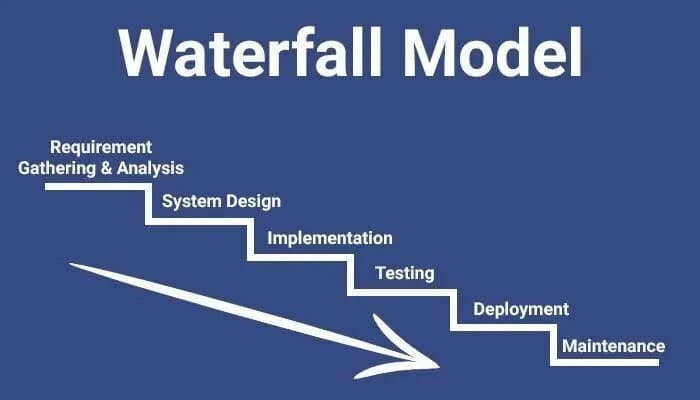
Source: BiPlus
As you can see, once the cycle ends, the team doesn’t return to it, which is why all development elements have to be near perfect from the get-go.
So, how does technical documentation fit into this?
Well, just like all other aspects of the project, documentation is also planned in advance. If any changes occur during the development process, the documentation is updated immediately.
Here’s how Adobe Business sees the value of the Waterfall methodology when it comes to tech documentation.
It is said that the Waterfall methodology follows the adage to ‘measure twice, cut once.’
The success of the Waterfall method depends on the amount and quality of the work done on the front end, documenting everything in advance, including the user interface, user stories, and all the features’ variations and outcomes.
As the Waterfall methodology itself is very rigid, so is the process of creating technical documentation.
This can be a good thing because it results in meticulously written, comprehensive internal and external documentation.
On the other hand, the lack of flexibility makes changes difficult.
So, if you’re venturing into a project that’s unlike any other you’ve previously done, you know you can expect changes throughout the development process, meaning that Waterfall is not the best approach to take there.
However, if you’re certain of your plans, then this methodology can instill structure into both the project and the documentation.
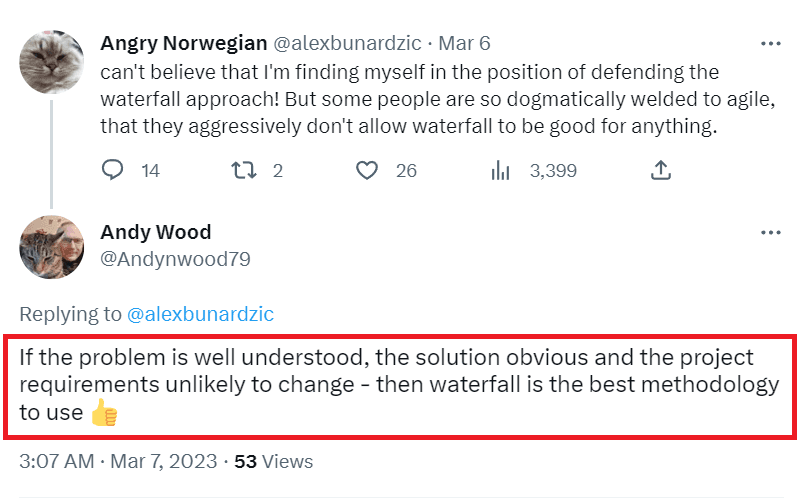
Source: Twitter
To sum up, technical documentation in the Waterfall methodology requires a lot of preparation. Instead of being an afterthought, the documentation is carefully planned and written in detail.
Seeing as some companies and development styles (for instance, startups) aren’t compatible with the Waterfall methodology, there’s a diametrically opposite way to develop and document products.
That’s right—we’re talking about Agile, the subject we’ll tackle next.
Technical Documentation in Agile Methodologies
Again, we’ll start by reviewing the methodology in general.
Agile is a software development methodology that revolves around the continuous delivery of working software created in rapid iterations.
These cycles are called sprints, and it takes several of them to finish a project.
You can find a visual representation of the Agile methodology below.
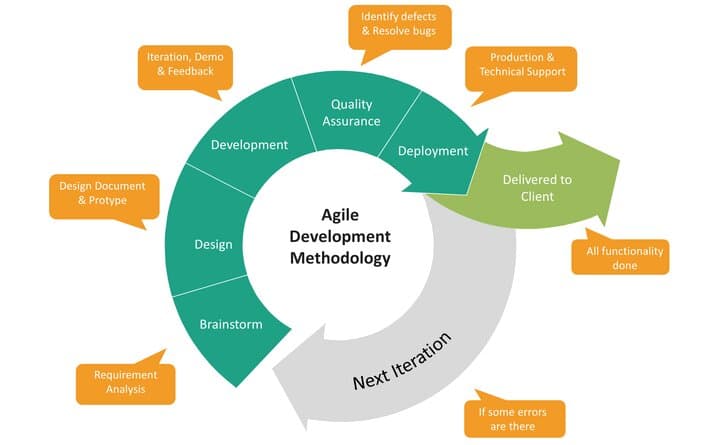
Source: BiPlus
Seeing as Agile works on the principle of iterative development and continuous improvement, it lets you treat the documentation the same way: what’s not documented now can be documented later, when needed.
Agile technical documentation is also closely related to just-in-time (JIT) documentation, an approach that encourages creating living, flexible tech documents instead of rigid ones.
All of these characteristics are in accordance with the core principles of The Agile Manifesto, which emphasizes that although comprehensive documentation has its place in software development, working software always comes first.
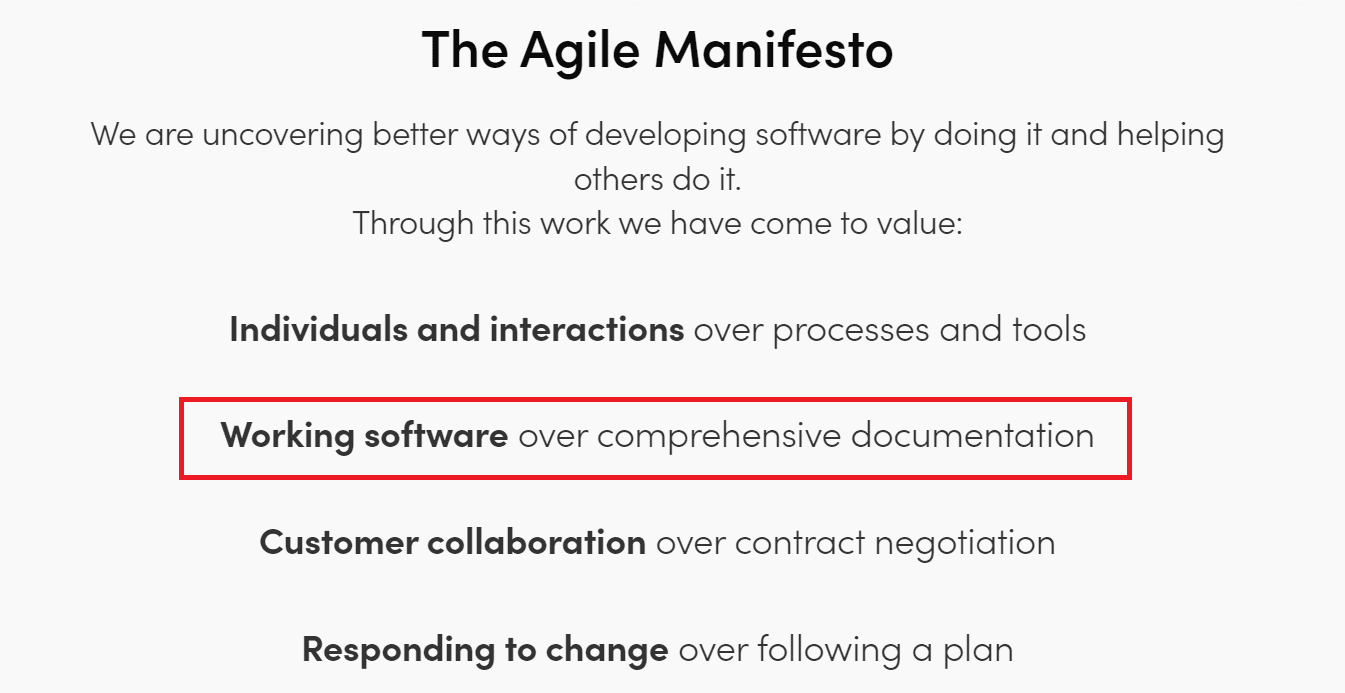
Source: Agile Alliance
Does this mean that Agile development companies should abandon documenting their products?
Absolutely not.
Instead, Agile aims to make documentation less intimidating—the focus is on documenting the important things, not capturing every single detail that may or may not turn out to be useful down the line.
That way, you can reduce the time spent documenting while still providing developers and end-users with helpful resources to learn about the product.
And although project managers and support staff are usually the ones who push for documentation, even developers themselves will tell you that it’s wrong to expect customers to use products that aren’t documented.
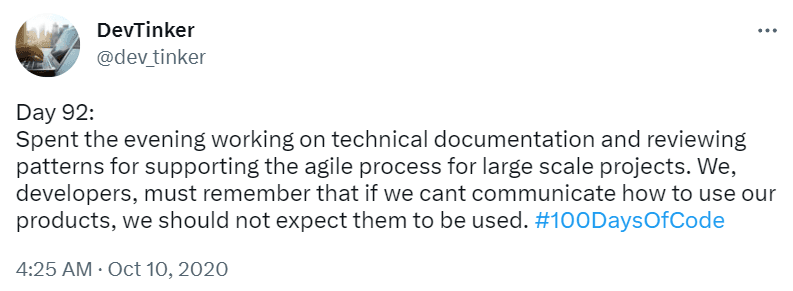
Source: Twitter
Because of that, Agile does provide time for writing technical docs—it just doesn’t let the documentation overshadow the rest of the project.
So, when you consider how flexible Agile is in terms of technical documentation, you can see why many companies choose this management approach.
It’s quick, it’s adaptable, and, most importantly, it lets you respond to the changes that inevitably occur during software development.
Documentation in Waterfall vs. Agile: Key Differences
The two methodologies may both aim to provide readers with helpful docs, but the process of getting there is quite different.
While Waterfall has a rigid approach to technical documentation, Agile allows for some leeway. Here’s how one site reliability engineer humorously describes the difference.
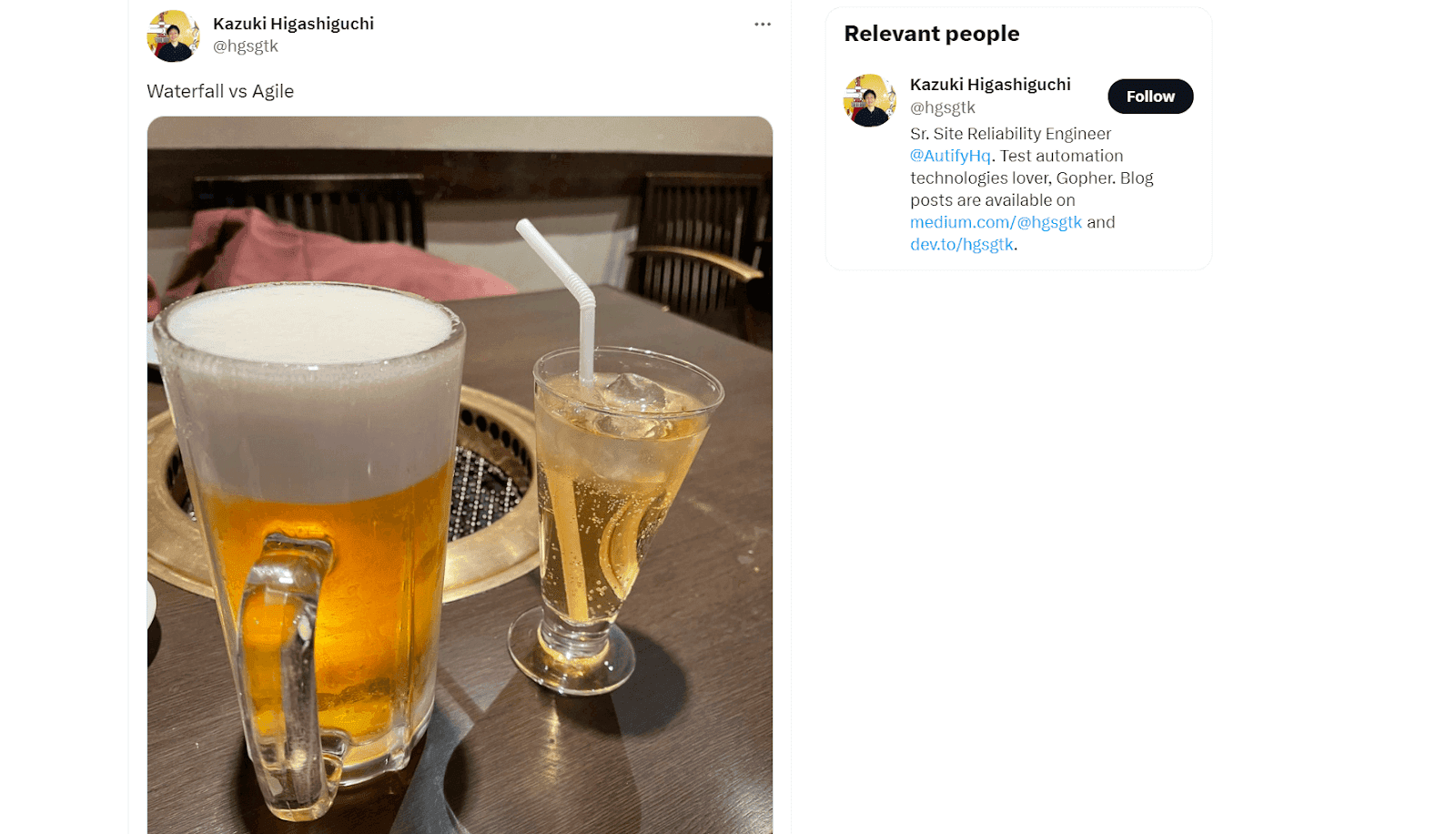
Source: Twitter
On a serious note, the numerous differences between tech documentation in Waterfall and Agile can be a bit challenging to grasp.
Because of that, we’ll now provide a side-by-side comparison of the key differences so that you have a complete review in one place.
Methodology
Waterfall
Agile
Amount of documentation
Every detail is documented.
Minimal documentation.
Types of documents
Documents related to planning, processes, standards, metrics. Product, system, architecture, requirements docs. End-user documents.
Only crucial docs, such as user guides or API documentation.
Documentation format
Standardized templates.
Relying on best practices that may differ from project to project.
Reviewing documentation
Formal review and approval processes.
The “Just Barely Good Enough” (JBGE) principle.
Making changes
Time-consuming because all documentation is interconnected.
Easily adaptable to changes.
Now that we’ve laid out the differences between documentation in Waterfall and Agile, it’s time to weigh which methodology is better.
Waterfall vs. Agile: Which One Is Better for Documentation
If you expected a clear-cut answer to the question of which methodology is better, you might be disappointed to learn that things are not so simple.
Each methodology has its place in software development and technical writing.
Still, the majority of companies lean toward Agile, according to a Hewlett Packard survey.
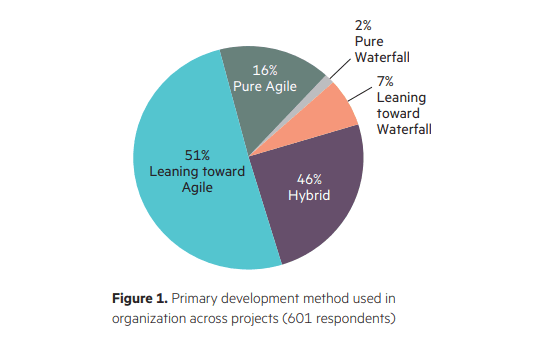
Source: Hewlett Packard
The reason for that might lie in the fact that software developers and technical writers alike appreciate the flexibility of the methodology.
Flexibility and adaptability are especially valuable in fast-paced companies where customer demands can change weekly, and Agile lets you adjust your technical documentation as your projects advance.
In that vein, one technical writer at TWi, a tech writing company, has compared documenting Agile projects to being a journalist.

Source: TWi
On the other hand, Waterfall might be a more suitable methodology for companies that favor a by-the-book approach to development and documentation.
For instance, if your company specializes in one type of service and you already rely on predetermined documentation practices, Waterfall can help you support the structure you already have in place.
Bear in mind that you don’t have to strictly adhere to one methodology. Until you find what works best for you, you can pick and choose the best elements from both Agile and Waterfall.
As long as you manage to create helpful documentation, it’s not that important how you get there. Here is also, a complete article about agile approach to writing technical documentation & just-in-time docs!
Still, deciding on one methodology will save your team time and spare them from decision fatigue, so we encourage you to review both methodologies and see which one would fit your team’s needs better.
Conclusion
There’s no one-size-fits-all solution when it comes to technical writing.
What works for other companies may not work for you, so you’ll have to evaluate your existing practices and compare them to Waterfall vs Agile Methodologies in technical documentation to see how you can upgrade the tech writing processes in your company.
Either way, the ultimate goal of both methodologies is developing high-quality products and, consequently, documentation, so you have nothing to lose by trying out both Waterfall and Agile to see which one you prefer.
Once you identify the most suitable methodology, you’ll likely also notice an improvement in documentation quality, and that’s what matters the most.
FAQ
Frequently Asked Questions
In Waterfall, documentation is planned and written up front to match the project’s linear phases—requirements, design, development, testing, and release. Teams aim for complete, detailed docs early, often using standardized templates and formal reviews with sign‑offs. Changes are controlled through a structured change‑management process because updates can ripple across many documents. This approach delivers comprehensive, consistent, and auditable documentation, making it a good fit for projects with stable requirements or regulatory needs. The trade‑off is less flexibility and higher effort when requirements evolve midstream.



